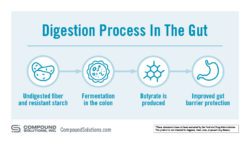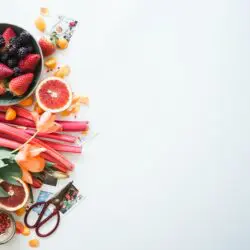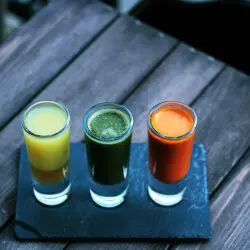What is a postbiotic?

A postbiotic is the material that comes from your good gut bacteria after it has fermented the undigested fiber and resistant starch your body ingested from vegetables.
That’s the short, easy answer when it comes to the question, “what is a postbiotic?” Let’s dive into the complete answer so that you know the difference between prebiotics and postbiotics and how important gut microbiome homeostasis is. Spoiler: gut health is human health. This is not a health fad, and we’re going tell you how beneficial postbiotics really are. So put down that kombucha, pick up that broccoli, and let’s talk postbiotics.
In a nutshell: The difference between Prebiotic, Probiotic, and Postbiotic
Postbiotics are the byproduct or “waste” compounds that results from the body’s natural digestion of fibers and resistant starches from vegetables. You can learn even more about postbiotics here. These fibers and resistant starches from vegetables and other sources we digest are prebiotics. During the digestion process, our gut begins a fermentation process. This process goes to work, turning the prebiotic fibers into short chain fatty acids like butyrate. Butyrate is necessary forgut barrier protection (also known as “the gut lining). And this, friends, is why we are all here. Butyrate helps protect our gut lining , and our gut lining is our last defense before bad bacteria (pathogens) reach our blood stream and internal organs. It was never about the kombucha!
Still with us on this postbiotic gut journey? Good.
Let’s take a short trip back to the beginning. We consume fiber and resistant starch from vegetables (prebiotics) and your probiotics start feasting! Having fiber and resistant startch is like Thanksgiving for your gut probiotics. Probiotics are live bacteria that live in your gut and manage things like metabolism and digestion. Soooo, they’re kinda important. Think of them as your personal rain forest, keeping the soil rich and fertile for lots of different plants. They even help ward off invasive species (aka bad bacteria)!
Now for the REAL question…..!
How do postbiotics work?
After you consume fiber and resistant starch and the pre- and probiotics do their job, your body will naturally produce postbiotics. These are materials leftover from the fermentation process. Postbiotis can include substances made from the fermentation process itself (say, butyrate), or even dead bacteria from cell walls of protein, peptides or enzymes.

“Dead bacteria” certainly does not sound good, but the reality is that postbiotics are all the good that comes from the fermentation process.
How good? Postbiotics include short-chain fatty acids and peptides. These help us maintain gut health and reduce gut inflammation.
The real benefits of postbiotics
You know probiotics mean “gut health” to many people? Well, now we realize gut health is MUCH bigger then probiotics. Now we now postbiotics are the foundation of gut health, not probiotics!
[Insert triangle with probiotics on the bottom, then another triangle where pro and postbiotics switch places]
This means that if you’re interested in gut health, now is the time to discover everything you can about the postbiotic revolution. If you simply want to maintain gut health and explore options in your own journey to gut wellness, you’re in the right place.
Eat your vegetables. That’s where we start. The real work happens when you come to a real understanding of the power of the gut microbiome and all the hard work it does for our bodies. Fun facts below!
The benefits of healthy gut microbiome include:
- Immune health
- Digestive health
- Supports healthy skin, brain, heart and muscles
- Helps maintain a healthy weight
How to get more postbiotics in your diet
Nothing beats whole foods. When you eat a healthy diet full of fibrous vegetables, you increase your prebiotic and probiotic activity, producing more postbiotics. The trouble is, 95% of Americans do not get enough fiber. This means, they are most likely not producing enough good bacteria gut activity, thereby, not producing postbiotics. No one wins, especially not your gut.
Action steps for more postbiotics:
Research the postbiotic options in the market. We suggest our very own patented Corebiome® because it is our #1 postbiotic and foundation of a healthy gut microbiome. You can find it more information about it here.
Foods in your fridge right now with postbiotic potential:
- Oats
- Onions
- Leeks
- Garlic
- Leafy greens
- Kale
Here is where to find CoreBiome® online or in your local vitamin shop
Interested in learning more about postbiotics? We’ve got you totally covered. Read more here and stay informed and vigilant when it comes to your gut health.
Want to use CoreBiome®? Contact us now.





